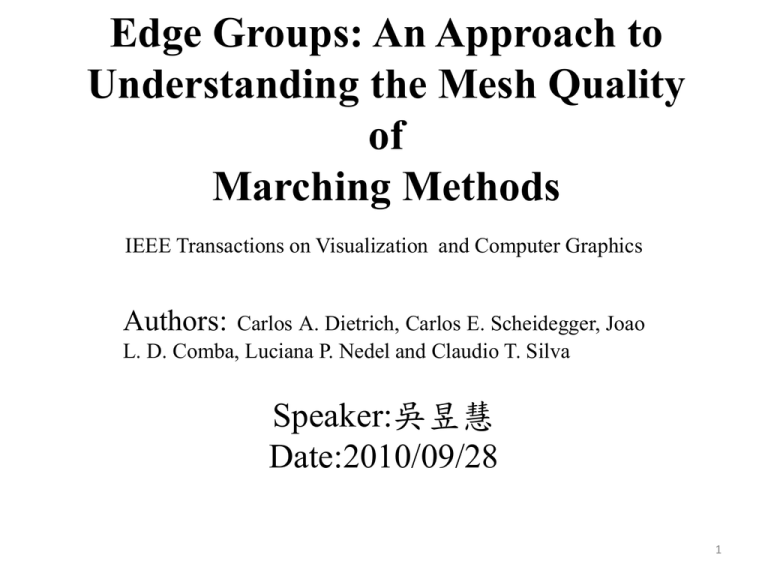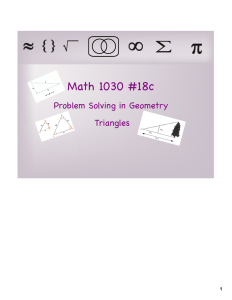Edge Groups: An Approach to Understanding the Mesh Quality of Marching Methods
advertisement

Edge Groups: An Approach to Understanding the Mesh Quality of Marching Methods IEEE Transactions on Visualization and Computer Graphics Authors: Carlos A. Dietrich, Carlos E. Scheidegger, Joao L. D. Comba, Luciana P. Nedel and Claudio T. Silva Speaker:吳昱慧 Date:2010/09/28 1 Outline • Introduction • Related Work • Edge Groups – Edge Groups for Cubic Cells • Improving Triangle Quality based on Edge Groups – Changing the MC Table – Improving Macet • Results • Discussion • Conclusions 2 Introduction • Marching Cubes (MC) • Introduce the concept of Edge Groups – MC and other marching methods • MC approximates a scalar field inside each cell by a collection of triangles 3 • Revisit marching methods to identify the edge groups in each case • By evaluating the histograms of triangle quality associated to each edge group of MC 4 • Apply a similar analysis to revisit Macet – Improves triangle quality by warping the locations of the MC grid before generating the mesh 5 Related Work • Original MC enumerates the 15 cases by inspection of the possible 256 cases, without a formal proof • Isosurface extraction methods are usually categorized by the general approach they use in computing the isosurface 6 Edge Groups • Edge groups to understand and analyze thetriangle quality generated by MC • Each cell generates a set of triangles • The quality of each triangle is dictated by the position of its vertices, some of which are shared among adjacent triangles 7 Edge Groups for Cubic Cells • Many symmetries of the cubic cell – Different edge configurations can define the same triangle – Same size and right angles between adjacent edges • An edge group represents a set of equivalent edge configurations that can be formed 8 9 • Any triangle generated by MC can be categorized into one of eight edge groups 10 • This means that simply removing edge group 2 from Marching Cubes cases will significantly reduce the probability of generating bad triangles 11 Improving Triangle Quality based on Edge Groups • Some observations that motivate our approach include – Each edge group has a different probability to generate bad triangles – All edge groups generate well-shaped triangles – Most edge groups can generate bad triangles • Since the proximity of the isosurface to a shared vertex may result in cut points close to each other 12 Changing the MC Table • In MC, a triangle is exactly defined – When only three cut points are found inside each cell • In Figure 3, show a box plot of the occurrences of edge groups across isosurfaces 13 14 Improving Macet • Macet is a technique that improves triangle quality by modifying the inner computation of MC 15 • Redefine Macet as a projection projp(e), which corresponds to the projection of the midpoint of the edge e onto the plane P tangent to the isosurface 16 17 • Apply a symmetric non-linear displacement using a modulation function – x axis we describe the original position of the intersection – y axis the normalized position of the displaced cut point 18 • Used has parameter value equal to 0.3 which we found experimentally to perform well 19 Results 20 • Shows that the edge transformations indeed improve triangle quality 21 22 Discussion • Method retains most of the performance advantages and simplicity of Marching Cubes • Method is intrinsically based on Marching Cubes, and, as it is, incapable of generating meshes that adapt to the features in the surface 23 24 Conclusions • The formulation shares the same combinatorial essence of MC case analysis – Takes a different angle by examining how edges are combined to form triangles • Edge groups also serve as a convenient framework to study strategies to improve mesh quality 25


